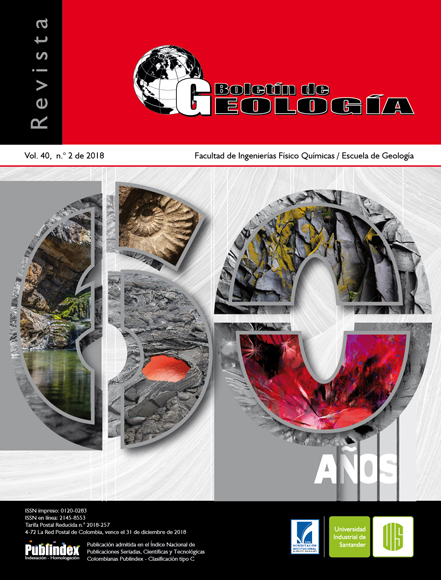Preliminary bulk characterization of Picacho tar sands, Pesca municipality (Boyacá, Colombia)
Published 2018-06-05
Keywords
- tar sands,
- Picacho Formation,
- heavy oil
How to Cite
Altmetrics
Abstract
The tar sands are mined in Colombia for paving the local roads. An example of this use is the tar sands of the Picacho Formation, located in the municipality of Pesca, Boyacá. The objective of this study is providing a preliminary bulk characterization to evaluate this resource as a possible source of unconventional hydrocarbons in this area. The study is limited to two fronts of exploitation named the La Emilia and Santa Teresa mines. The methods used comprise elemental analysis, physico-mechanical test, SARA and pyrolysis. The results determine that the unit is composed of siliceous sandstones. The percentages of sulfur are low in most of the samples, except one that reaches 5%, the API gravity between 22.4 and 9.2 indicates that they range between medium and extra heavy crude, the oil fractional composition reflects a higher proportion of resins and asphaltenes, the pyrolysis indicates a high volatile content that completely distill at temperatures below 500ºC.
Downloads
References
Alayon, M. (2004). Asfaltenos. Ocurrencia y floculación. Cuadernos FIRP. Mérida: Universidad de los Andes.
ANH. (2009). Petróleo y futuro. Agencia Nacional de Hidrocarburos. Consultado el 20 de noviembre de 2014. http://censat.org/es/analisis/loshidrocarburos-no-convencionales-un-crudopanorama-2.
ASTM D 88. Standard Test Method for Saybolt Viscosity. American Society for Testing and Materials (ASTM). 2013.
ASTM D 95. Standard Test Method for Water in Petroleum Products and Bituminous Materials by Distillation. American Society for Testing and Materials (ASTM). 2005.
ASTM D 96. Standard Test Methods for Water and Sediment in Crude Oil by Centrifuge Method (Field Procedure). ASTM D96-88. American Society for Testing and Materials (ASTM). 1998.
ASTM D 129. Standard Test Method for Sulfur in Petroleum Products (General High Pressure Decomposition Device Method). American Society for Testing and Materials (ASTM). 2011.
ASTM D 189. Standard Test Method for Conradson Carbon Residue of Petroleum Products. American Society for Testing and Materials (ASTM). 2014.
ASTM D 240. Standard Test Method For Heat Of Combustion Of Liquid Hydrocarbon Fuels By Bomb Calorimeter. American Society for Testing and Materials (ASTM). 2009.
ASTM D 287. Standard Test Method for API Gravity of Crude Petroleum and Petroleum Products (Hydrometer Method). American Society for Testing and Materials (ASTM). 2012.
ASTM D 482. Standard Test Method for Ash from Petroleum Products. American Society for Testing and Materials (ASTM). 2012.
ASTM D 3904. Test Method for Oil From Oil Shale (Resource Evaluation by the Fischer Assay Procedure) (Withdrawn 1996). American Society for Testing and Materials (ASTM). 1996.
Demirbaş, A. (2002). Asphaltene yields from fie types of fuels via different methods. Energy Conversion and Management, 43(8), 1091-1097. doi: 10.1016/S0196-8904(01)00085-1.
EIA. (2012). Total Petroleum and Other Liquids Production. US Energy Information Administration. Consultado el 20 de noviembre de 2014. http://www.eia.gov/countries/cab.cfm?fis=VE.
Espitalié, J., Laporte, J., Madec, M., Marquis, F., Leplat, P., Paulet, J., and Boutefeu, A. (1977). Rapid method for source rocks characrerysation and for determination of petroleum potential and degree of evolution. OGST - Revue d’IFP Energies nouvelles, 32(1), 23-42. doi: 10.2516/ogst:1977002.
Gerner, N.V, Koné, M., Ross, M.S., Pereira, A., Ulrich, A.C., Martin, J.W., and Liess, M. (2017). Stream invertebrate community structure at Canadian oil sands development is linked to concentration of bitumen-derived contaminants. Science of the Total Environment, 575, 1005-1013. doi: 10.1016/j.scitotenv.2016.09.169.
He, L., Li, X., Wu, G., Lin, F., and Sui, H. (2013). Distribution of saturates, aromatics, resins, and asphaltenes fractions in the bituminous layer of Athabasca oil sands. Energy & Fuels, 27(8), 4677-4683. doi: 10.1021/ef400965m.
Hong, P.K.A., Cha, Z., Zhao, X., Cheng, C., and Duyvesteyn, W. (2013). Extraction of bitumen from oil sands with hot water and pressure cycles. Fuel Processing Technology, 106, 460-467. doi: 10.1016/j.fuproc.2012.09.013.
Hunt, J. (1995). Petroleum geochemistry and geology. (2nd ed). New York: W.H. Freeman and company.
Jiménez, L., y Cruz, M. (2004). Caracterización y evaluación de reservas del yacimiento de asfaltitas en el sector de Isaza, municipio de Victoria, departamento de Caldas, Colombia. Manizales: Universidad de Caldas.
Lechner, C.A., Liapis, A.I., and Findley, M.E. (1989). A pyrolysis process for tar sands. The Canadian Journal of Chemical Engineering, 67(1), 85-95. doi: 10.1002/cjce.5450670112.
Liu, Q., Cui, Z., and Etsell, T.H. (2006). Characterization of Athabasca oil sands froth treatment tailings for heavy mineral recovery. Fuel, 85(5-6), 807-814. doi: 10.1016/j fuel.2005.08.032
Pettijohn, F., Potter, P., and Siever, R. (1987). Sand and sandstone. (2nd. ed). New York: Verlag Springer.
Qing, W., Chunxia, J., Qianqian, J., Yin, W., and Wu, D. (2012). Combustion characteristics of Indonesian oil sands. Fuel Processing Technology, 99, 110-114. doi: 10.1016/j fuproc.2012.02.006.
Reyes-Caballero, F., Fernández-Morales, F.H., y Duarte, J.E. (2016). Panorama energético. Revista de Investigación, Desarrollo e Innovación, 7(1), 151-163. doi: 10.19053/20278306.v7.n1.2016.5605.
Reyes, Í. (1984). Geología de la Región de Duitama - Sogamoso - Paz de Rio - Belencito. Sogamoso: Universidad Pedagógica y Tecnológica de Colombia.
Ruíz-Acero, J.C., Reyes-Ortiz, O.J., y Moreno-Anselmi, L.A. (2016). Evaluación del comportamiento mecánico de asfalto natural a partir de muestras a temperatura ambiente provenientes de Caquetá, Colombia. Revista de Investigación, Desarrollo e Innovación, 6(2), 145-154. doi: 10.19053/20278306.3115.
Sandoval, J.A. (2007). Estudio geológico y caracterización de las asfaltitas de la vereda de Paloblanco en el municipio de Vélez Santander. Tesis, Universidad Pedagógica y Tecnológica de Colombia.
Sherval, M. (2015). Canada’s oil sands: The mark of a new “oil age” or a potential threat to Arctic security?. The Extractive Industries and Society, 2(2), 225-236. doi: 10.1016/j.exis.2015.01.011.
Sleep, S., McKellar, J.M., Bergerson, J.A., and MacLean, H.L. (2017). Expert assessments of emerging oil sands technologies. Journal of Cleaner Production, 144, 90-99. doi: 10.1016/j.jclepro.2016.12.107.
Sparks, B.D., Kotlyar, L.S., O´Carroll, J.B., and Chung, K.H. (2003). Athabasca oil sands: Effect of organic coated solids on bitumen recovery and quality. Journal of Petroleum Science and Engineering, 39(3-4), 417-430. doi: 10.1016/S0920-4105(03)00080-9.
Speight, J.G. (2016). Introduction to enhanced recovery methods for heavy oil and tar sands. (2nd. ed). Boston: Gulf Professional Publishing.

